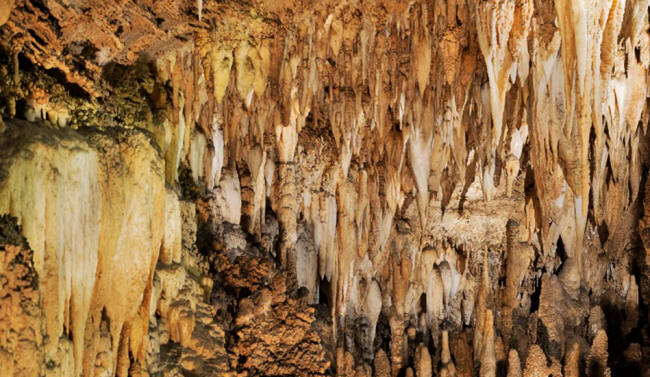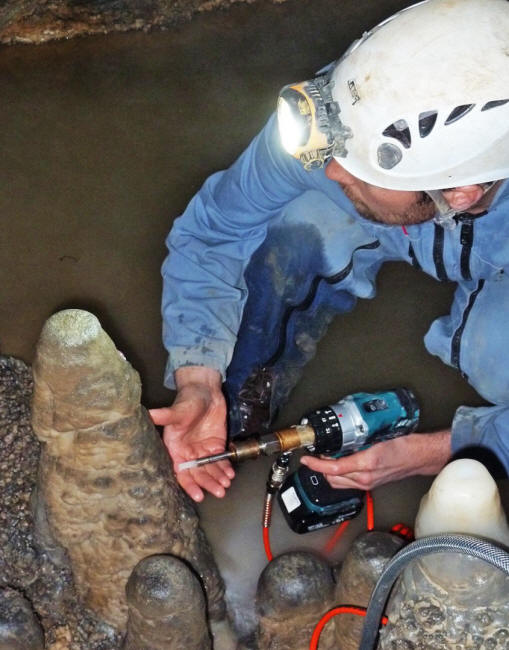|

by Natalie Parletta
March 13,
2020
from
CosmosMagazine Website

Galeria delle Stalattiti, Corchia Cave.
Credit: Linda Tegg
Analysis
of global glaciations
over the last
million years
confirms its
significance...
International research
covering the past million years of global glaciations shows that
small changes in the tilt of the Earth's axis -
obliquity - is important for
triggering the end of ice ages, or glacial terminations.
The study (Persistent
influence of obliquity on ice age terminations since the Middle
Pleistocene transition), published in the journal
Science, challenges previous contentions that precession -
rotational changes that govern when the Earth is closest to the Sun
- is most important.
"Ice ages are the
most fundamental feature of Earth's climate over the last few
million years," says corresponding author Russell Drysdale from
the University of Melbourne, Australia.
Nearly 200 years ago, it
was proposed that transitions from glacial to interglacial periods -
shorter intervals with temperate climates such as the current
Holocene that started about 11,600 years ago - are triggered by
changes in Earth's orbital geometry, and this notion ultimately
became part of
Milankovitch's astronomical
theory of ice ages in the early
1900s.

Taking a mini-core
from a
stalagmite for radiometric dating.
CREDIT: Russell Drysdale
But it's been difficult to determine which orbital parameter is most
important, as techniques to study ocean sediments, which have been
used to understand glacial terminations, have been unable to
properly date them past 40,000 years ago.
And timing is important, says Russell Drysdale.
"Refining what
exactly drives the ice-age cycles requires an understanding of
when exactly they occurred," he explains.
Advances in geochronology
and better understanding of spatial responses to terminations have
facilitated the use of
speleothems to indirectly date
ocean sediments, a technique that a Chinese study used in 2016 to
date terminations back to 640,000 years ago - as far as
uranium-thorium dating would allow.
That study (The
Asian monsoon over the past 640,000 years and ice age terminations)
suggested that
precession was most important,
which determines the occurrence of high summer insolation intensity
thought necessary to melt the ice sheets in the Northern Hemisphere
and trigger a glacial termination.
Drysdale's group used their advances in a new uranium-lead dating
technique to peek further back at this "ice-age problem".
First, they
constructed a detailed record of ocean conditions between
980,000 and 800,000 years ago - a key part of Earth's history
that covers two terminations - from ocean sediments sampled near
Portugal in the North Atlantic, which lies in the path of
meltwaters from collapse of the massive North American and
Eurasian ice sheets.
Then they sampled cave mineral deposits from speleothems from
the nearby Corchia Cave in Italy, which has a climate closely
aligned with the North Atlantic.
"When the North
Atlantic coughs, Corchia Cave sneezes," says Drysdale.
From these speleothems
the team compiled a detailed climate record and time scale.
"Because the
speleothems and ocean sediments record the same climate
signals," Drysdale explains, "we could marry the two data sets
together, and thus tie the detailed ocean record of both
terminations to the precise speleothem chronology."
Their key finding was
that obliquity is as important as precession - if not
more so - for triggering the glacial terminations.
"This is because high
tilt angles mean stronger summers in both hemispheres," says
Drysdale.
"Once triggered, high
summer energy in the Northern Hemisphere high latitudes, which
requires both high obliquity and strong precession, ensures a
termination's completion."
Their analysis also
refuted claims, once and for all, that the two terminations bracket
the "100,000-year cycle".
Instead, he says we've gone from predominantly single 40,000-year
cycles prior to around one million years ago to a cluster of
two 40,000-year cycles.
But the rates at which the two terminations were completed were
vastly different:
-
the older one,
960,000 years ago, took a few thousand years
-
the more recent
one, about 875,000 years ago, took around 10,000 years
Comparing their data with
previous studies for nine younger terminations they showed that
obliquity played a key role in them and their duration.
By using information about the timing of termination events,
Drysdale says they've been able to refine understanding about the
role of astronomical influences on sweeping changes in Earth's
climate.
Does this throw any light on our next ice age?
No, he says.
"The closest orbital
analogue to the Holocene occurred about 785,000 years ago, which
was not covered by our study. This interglacial lasted 10,000 to
15,000 years, depending on where you draw the line."
They are now continuing
their work into the
Early Pleistocene ("the so-called
40,000-year world") to further test their emerging hypothesis that
tilt and precession are both important for the pacing
of these cycles...
| 


